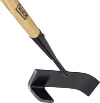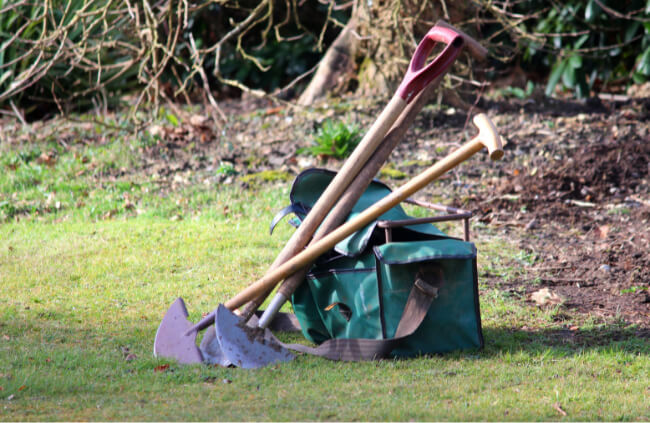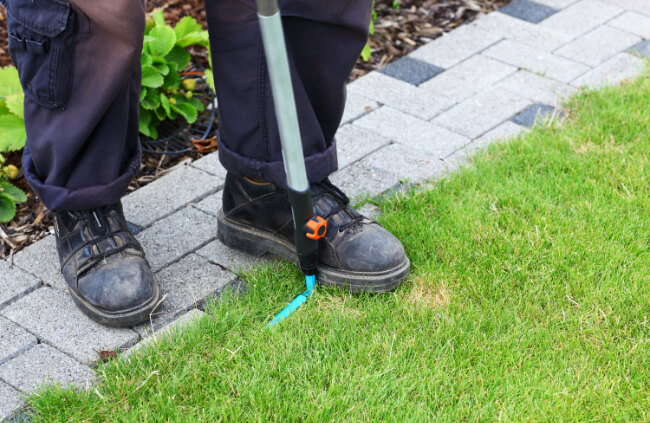Steel garden edgers are an essential part of any garden tool kit. Why? Because the first rule of garden maintenance is ‘hedges and edges’. Keep your hedges neatly pruned, and your lawns tidily controlled and the rest of your garden can be as wild as you like. It will, without exception, look good.
Steel garden edgers are a breeze to use, easy to store, and do the job of edging lawns better than most electric or gas powered garden edgers. In this buyer’s guide to garden edgers, we’ll share some thoughts on the different blade types, and a handful of our favourites for 2025.
More...
Top Pick

Premium Choice

Best Value

Product | Our Rating | Price | |
|---|---|---|---|
1. Roamwild Multi-Digger Garden Edger |  | ||
2. Radius Garden 22611 Root Slayer Edger |  | ||
3. Yard Butler Heavy Duty Step Edger |  | ||
4. Draper 14307 Carbon Steel Garden Edger | |||
5. Spear & Jackson SJ-3164EL Steel Garden Edger | |||
6. Fiskars Long-Handle Steel Garden Edger | |||
7. Kwik Edge Garden Edger, Weeder & Soil Cultivator |  |
Steel Garden Edgers Tool Buyer’s Guide
What are Steel Garden Edgers?

Steel garden edgers are hand tools that cut easily through lawn roots and compacted topsoil. They are designed to be used at least twice a year, without taking too much away from your lawns, and give ultimate control to gardeners.
There are many different designs of lawn edging tools, ranging out into the power-tool world, and they do indeed offer faster work, and in some ways, convenience. However, when it comes to a perfectly manicured lawn, nothing beats the hands on approach, and the careful eye of a gardener.
In this buyer’s guide, we’ll cover everything from blade materials and blade types, to handle structure and comfort. Once you’ve got those basics down, check out our full list of the best garden edgers to buy in 2025.
What to Look for When Buying Steel Garden Edgers
There’s a huge scope of variety amongst garden edger designs, but they do differ from standard hoes, in that most are pointed and others are serrated. Their handles tend to be more about downward forces too, so you’re less likely to see D-shaped hands, and more likely to come across T-shaped, or oval handles instead.
Brand plays a part but it’s worth looking outside your usual garden tool suspects because there are some great specialist lawn care brands out there too.
Handle and pole materials
I will nearly always go for a timber handle on my tools, because I’m a sucker for good-looking tools, and love having neat lines of traditional tools hung up in my garden shed.
However, when it comes to lawn tools like manual garden edgers it can pay to pay a little more. For example, carbon steel and stainless steel landscape edgers are more durable, and won’t mind being left out in the rain occasionally.
They are harder to fix if something goes wrong, but they’re also more comfortable to use.
Handle structure
As well as looking for the materials, the actual structure and shape of the handle will make a big difference. Crucially, lawn edging isn’t something you do every weekend. It’s a twice-yearly job for most of us that will take an entire day to do right on most average-sized lawns.
So any handle that allows you to use both hands, or to apply even downward pressure, is ideal.
D-shaped handles, or short poles with no handle, for example, mean you’re bending to use the tools. Oval handles, T-handles, or dual-grip handles mean you’re standing upright. That makes it infinitely easier to spend an entire day doing one task, and doing it well.
Blade materials
Carbon steel, stainless steel and powder-coated steel are pretty much the only head/blade materials you should be looking for with any lawn edging tool. They are designed to cut through soil in all weather, and even the more rust-resistant they are, the better.


Get Your Free Guide:
Master Growing Australian Natives eBook
A Must Have Complete Guide for Every Australian Garden
Get Your Free Guide:
Master Growing Australian Natives eBook
A Must Have Complete Guide for Every Australian Garden
Stainless steel is probably the cheapest head material, and will save you money, but you’ll need to clean it, and it will wear faster than carbon steel or powder-coated steel.
Carbon steel is tougher, but does need cleaning after each use. It will hold its sharp edge for longer though.
Different Types of Steel Garden Edgers
The function of garden edger is to cut through roots and soil. For that reason they are nearly always either incredibly sharp, pointed or serrated. Some, however, are a little bit different, so let’s take a look at the designs.
Curved Lawn Edgers

Curved lawn edgers, particularly the one pictured, offer control. They also, depending on the grade of the curve, and any additional scraping edges, cut under the lawn to slice any roots and developing stolons that would creep into your borders (the overgrown roots that cause untidy edges).
Curved landscape edgers are harder to use, because they take a bit of care, and usually need using at an angle, but they offer superior results, and longer lasting, cleaner edges.
Serrated Lawn Edgers
Serrated edgers make everything easier, particularly on tougher lawns like Bermuda grass, which tends to have thicker root systems. They’re also great at cutting through tap roots, which might not kill the weeds, but does keep them briefly under control, and will help to establish any boundaries in spring, and keep borders tidy come winter.
The only downside to serrated lawn edging tools is that they are harder to sharpen, but a good knife block should do the trick.
Pointed Lawn Edgers
Pointed lawn edges are the base design for any landscape edging tools. Much like a traditional half-moon hoe, they have simple handles, and simple, usually flat, blades. They cut through 99% of lawns really well, and are the fastest type of lawn edger to use.
How to Use a Steel Garden Edger
The only way to use a steel garden edger properly is by holding it vertical, and pushing evenly with one foot and both hands on the handle.
When you’re cutting, it’s important not to take too much away, unless you’re planning on extending your borders. Stick to the existing edge, and resist the temptation to come in an extra inch. Just take off the excess spread.
Lift out with a slight flick, and move to one side in the same direction until you come all the way back around. When you’re finished, you’ll have little sods of grass in your border. Pick them up, and rake over the edge of the border to loosen up the soil again.
That’s it. It’s simple, but time consuming, and will create the neatest lawn you’ve ever had.

When to Use Steel Garden Edgers
If you’re maintaining public parks or golf courses, it’s important to regularly run lawn edgers along any lines where lawns meet hard paths. Nothing looks worse than fluffy edges on hard landscaping.
For DIY use, most gardeners will be cutting back lawns at the point where they meet soil borders. Personally, I do this twice a year, once in late spring/early summer before the garden is in full swing, and once in late autumn/early winter, to keep the slightly bedraggled winter borders looking tidy until spring.
Maintaining Steel Garden Edgers
After each use, clean your garden edging tools with a stiff brush. Use soapy water or disinfectant if necessary (particularly if you’ve used them to cut around any bad patches of lawn).
After cleaning, dry them thoroughly to remove any moisture and prevent rust. Oil them lightly, and store them away until you need them.
When it comes to sharpening lawn edgers, a traditional whetstone, or knife block will do the job perfectly. Run the blade carefully in a single direction against the sharpening block about ten times.
Steel Garden Edgers in Australia
1. Roamwild Multi-Digger Garden Edger

This is a beast of a lawn edger, with tough, serrated edges, capable of sawing stumps and small branches, as well as just cutting through roots.
The dual-grip handle gives ultimate pressure control, and allows you to work at a comfortable position, while the mid-shaft grips mean you can use this large-faced lawn edger as a spade if you need to.
It’s a mid-priced tool, so definitely for passionate or perfectionist gardeners, but one to consider if you’re seriously looking for the best lawn edgers out there.
Pros
Cons
2. Radius Garden 22611 Root Slayer Edger

The double-pointed blade on this lawn edger by Radius cuts through young and reasonably established roots that might be running along your lawn edge.
If you’ve ever found an incursion from trees and shrubs into your lawn, you’ll know that they can cause bumps, which not only look bad, but make it harder to mow.
An annual cut around the edge of your lawn with this edger will only tidy up the lawn itself, but it’ll stop the border from creeping the other way too.
Pros
Cons
3. Yard Butler Heavy Duty Step Edger

The dual connection from the shaft to the blade makes this steel garden edger one of the best there is. It’s incredibly durable, and won’t break under heavy pressure.
The comfortable T-shaped handle offers great grip, and means you can work upright without needing to bend over at all.
The serrated blades are tricky to sharpen when the time comes, but the powder-coated steel means that that’s not very often.
Pros
Cons
4. Draper 14307 Carbon Steel Garden Edger

This timber-handled carbon steel lawn edger is a truly traditional tool by Draper.
Like all timber-handled tools, it’s easy to fix and replace parts if necessary, but with proper care and attention it should last a lifetime.
There’s nothing fancy about the blade, other than a gentle point which makes it easier to cut through tough thatch.
That simplicity, while not exciting, means it’s an incredibly easy tool to use, and one that can be used in a variety of ways to maintain your garden and keep it looking good.
Pros
Cons
5. Spear & Jackson SJ-3164EL Steel Garden Edger

While not dissimilar from more traditional tools, this stainless steel garden edger by Spear & Jackson is a great alternative to timber or fibreglass.
It’s lightweight, easy to use, and simple to sharpen (but will need some care to not over sharpen). The results are clear though with neat lawn edges in no time, and a pain-free back even after a few hours’ use!
Like all Spear & Jackson tools, you know you’re buying quality here, and the materials just make sure you get the value you need when you’re buying basic tools.
Pros
Cons
6. Fiskars Long-Handle Steel Garden Edger

I like this steel edger from Fiskars, but there’s something about the handle that feels a little bit flimsy. The connection is a single rivet, and with the pressure required over large areas it might wear over time.
At odds with that though is the incredibly durable shaft and blade, firmly welded together, which seems like it would last a lifetime. If you’re after a durable tool on a budget, this is a great choice, but you might need a replacement handle after a few years.
Pros
Cons
7. Kwik Edge Garden Edger, Weeder & Soil Cultivator

Kwik Edge’s multi-tool garden edger, with its durable steel blade, and cleverly curved head is ideal for making sure you’ve done a truly thorough job. More importantly, it’s a job that lasts.
The angled base blade runs underneath your lawn, trimming the roots at the edge of any grassy space. That means the roots take longer to re-establish, and your edging job will last for longer.
The only downside as well as a high price point, is the long, straight shaft, with no handle to grip. That means you’ll be working at an angle all day long. If you’re willing to put the effort in with this tool though, you’ll get better results than with any other lawn edger.
Pros
Cons
Steel Garden Edger Top Picks
Top Rated Steel Garden Edger


I’m really quite enamoured by this lawn edger from Roamwild. It’s marketed as a multi-digger and garden edger, and it’s spot on. The wide face makes digging a charm, and landscape edging a breeze.
Simple design features mean it’s not just easy to use, but it’s comfortable too, offering comfort while working upright around lawn edges, or while bending to dig.
Oh, and just to add a cherry on top, the serrated section on the side of the blade is so tough that it not only cuts through hard earth, but can be used as a saw blade on tree stumps, roots, and problem branches too.
Premium Choice Steel Garden Edger


At a slightly higher price, Radius Garden’s Root Slayer Edger might seem like a luxury tool choice, but it’s actually a pretty perfect piece of design. The twin pointed blade can cut through shallow roots that might incur on your lawn, and the sharply serrated sides mean it can cut through any type of soil with ease.
The round handle might look impractical, but it’s incredibly comfortable to use, allowing a little wiggle room while you work to adjust your grip if needed.
Best Value Steel Garden Edger


For any budget-savvy gardeners out there looking for a heavy duty garden edger that doesn’t break the bank, this powder-coated steel step edger is about as perfect as they come.
It’s not as lightweight as more expensive models, and it’s not as comfortable either, but its soft-grip T-handle is easy to use, and its clever forked shaft makes heavy soils easy to work with. For me, that makes this the best budget garden edger you’ll find for 2025.
Steel Garden Edgers Frequently Asked Questions
What is the fastest way to edge my lawn?
The fastest way to edge your lawn is using a strimmer or electric lawn edger. Like anything done in haste though, it won’t leave you with perfect results, and can take longer to tidy up than it took to carry out.
What is the best way to edge my lawn?
The best way to edge your lawn is slowly, carefully, and with a manual lawn edging tool. They offer more control, and a crisper, longer-lasting finish, that removes roots, as well as top growth.
How do you cut between lawns and paths?
To cut between your lawn and your path, you’ll need a garden edger with a flat blade. Push down, tightly against the edge of the path, or edge strip, with the foot-plate facing towards you, so it overlaps the path, not the lawn.
When you pull back up, flick excess roots and lawn to one side to sweep later.
Should you mow or edge your lawn first?
Always mow your lawn before using a lawn edger. Long grass can just pull down with the force of the edger, and won’t cut through as easily as short grass, sometimes making it harder to cut through roots.
How many times a year should you edge your lawn?
It’s important to edge your lawn at least once a year, but two years should be standard for most homeowners to keep a really tidy patch of grass. Outside domestic settings, the more often the better, particularly around public walkways.
How deep should you edge your lawn?
Nearly all lawn edgers are 10-15cm deep. That’s ideal for lawn edging as it removes and severs any underground roots. If you’re lucky, it’ll pull them up when you remove the edger too.
Is garden edging worth it?
Garden edging is always worth the effort. It not only improves the health of your borders, but it will prevent lawns from yellowing on thin roots over inappropriate soil. Edging your lawns should be the first step in any annual garden maintenance plan.
Make Edging Your Garden Easy by Using the Best Steel Garden Edgers for 2025
Maintaining your lawn edges is essential. It reduces problems in your borders, and stops hungry grass from depleting nitrogen in other soil unnecessarily. If you keep a wildflower patch, or like leaving your lawn to grow long (as we do here in half the garden for pollinators) clean edges help it look tidy and intentional, rather than overgrown.
So now all you need is the best steel garden edger you can buy, a bit of energy, and a day in hand, and you’ll be sunbathing on your pristine, crisp-edged, lawn in no time.
Published on August 2, 2023 by Gary Clarke
Last Updated on December 23, 2025




